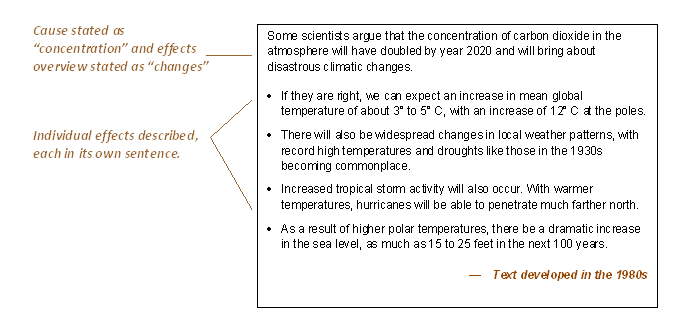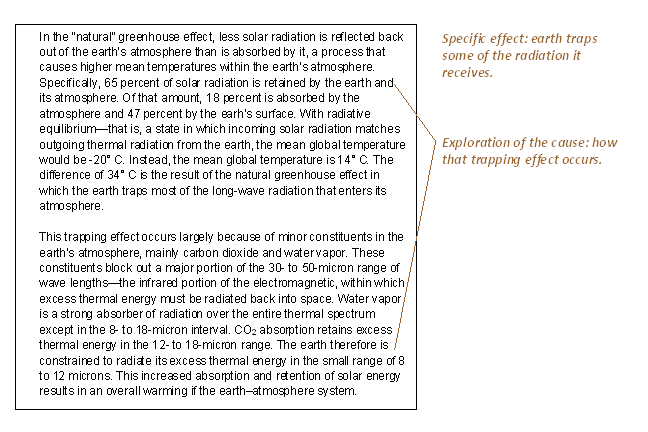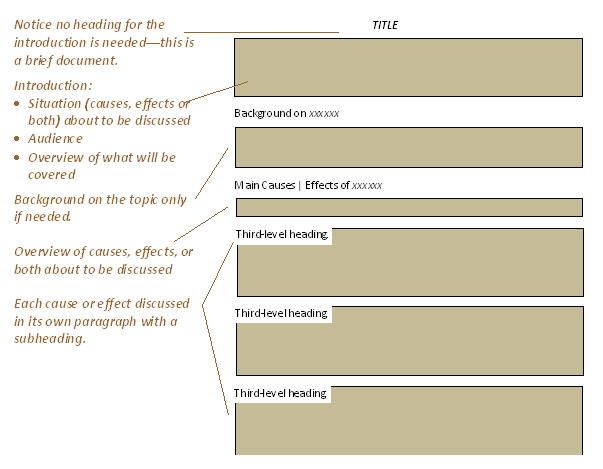Please click here to help David McMurrey pay for web hosting:
Donate any small amount you can !
Online Technical Writing will remain free.
Another useful information structure often used in technical writing is the discussion of causes and effects.
What Is a Cause–Effect Narrative?
Narratives like these answer questions such as the following:
- What are (or were) the causes of this? How and why does (or did) this happen?
- What brought about a situation, problem, or accident?
- What are (were or will be) the effects, results, or consequences of this? What will happen if a certain situation or problem continues?
- How does this work? What causes this to function as it does?
- Why won't this thing work? What's wrong with it?
- What changes will occur if a certain plan or action is taken?
- How can a certain problem or situation be avoided?
- What are the advantages, benefits, or disadvantages of an action or object?
- What are one or more potential solutions to a problem?
Note: See the complete example of a causal narrative.

Some examples:
- What causes tornadoes? What sorts of damage do tornadoes cause?
- What will happen if the world continues to use petroleum resources at its current rate?
- What were the causes of the Great Depression?
- What are the effects of an economic recession?
- What makes a microwave oven work? (Does this sound like your seven-year-old?)
As you can see from these examples, we can discuss the causes and effects of human or social processes, natural processes, mechanical or physical processes, historical or economic processes, meteorological or biological processes, and on and on.
If you think about it, there's not much difference between process narrative and causal narrative. Both occur over time; steps in a process often involve causes and effects. The distinction depends on your purpose and emphasis: process narratives are primarily concerned with how an event occurs; causal narratives, with why an event occurs. Process narrative focuses on the chronology of something; causal narrative focuses on the causes and effects.
- I can tell you step by step how to take a photo or what events occur inside the camera when you take a picture—that's process.
- But I can also explain to you what physical and chemical principles are at work when you take a photo, what principles actually enable you to take a photo—that's causal narrative.
For some topics, however, such as explaining tornadoes, it's almost impossible to make a distinction. Here are some contrasting examples:
| Subject | Process narrative | Cause–Effect narrative |
| Lightning | How to safeguard home appliances from lightning | What natural phenomena cause lightning |
| Instruction writing | How to set up understandable instructions | What causes instructions to be unclear |
| Acquisition of language by childr enrapidly | How to help children learn language more rapidly | Why certain children learn language more rapidly |
| Growing tomatoes | How to plant and care for tomatoes | Reasons why tomatoes are less productive |
| Air conditioning | How cool air is produced by conventional systems | Why your air conditioning is costing you more this summer |
Here are some common reasons why you may need to discuss causal and effects:
- You need a record of the damage done by something. Photographs work, but words may also be needed.
- You need an account of the scientific principles at work in a process so that you can understand what you are doing in an instructional procedure.
- You need to understand the causes of something so you can have a better understanding of how to control or eliminate it.
- You need to understand the effects of something so that you can work to prevent it or increase its likelihood.
How to Organize Cause–Effect Narratives?
How you organize the contents of a causal narrative depends on how many and what combination of causes and effects you discuss:
- Single cause–single effect—A single cause can lead to a single effect; for example, a radiator leak can cause the car to overheat.
- Multiple causes–single effect—Many different causes can be seen as leading to one effect: for example, high unemployment, high interest rates, and high real estate costs (causes) might lead to decreased real estate sales (effect).
- Single cause–multiple effects—A single cause can be seen as producing numerous effects. For example, proponents of the greenhouse effect believe that increased CO2 in the atmosphere (cause) will lead to changes in weather patterns, higher temperatures, drought, increased storm activity, and higher sea levels (effects).
- Sequential causes and effects—One cause can bring about an effect, which in turn becomes the cause of another effect, and so on. For example, proponents of the greenhouse effect argue that increased burning of fossil fuels (cause) leads to increased CO2 in the atmosphere (effect) which in turn is the cause of less thermal energy being reradiated out of the system (effect) which in turn becomes the cause of increased global temperatures.
- Alternate causes and effects—Causes and effects can be alternating. For example, if the car won't start (effect), it may be because of a dead battery (alternate cause 1), no gas in the gas tank (alternate cause 2), or a faulty part (alternate cause 3).

Organization of effects in a short causal narrative. First, the cause is stated; then the effects are discussed one after another.
Consider a simple example: imagine you want to discuss how a single situation has led to a number of problems, in other words, one cause leading to several effects. In a single paragraph, the first couple of sentences might focus on the cause; each of the following sentences would focus on the effects. In an extended narrative, there might be a paragraph on the cause, and a paragraph on each of the effects. The preceding schematic diagram of a causal narrative in shows you how the single-paragraph approach would look.
How to Discuss Causes and Effects?
Actual discussion of causes and effects is not as immediately identifiable as descriptive or process writing are. Typically, causal narratives talk about events and describe things. What makes causal narratives distinctive is the use of transitional words to indicate the causes and effects.
In this sentence:
Increased deficit spending by the government leads to increased inflation
the verb "leads to" establishes the connection between a cause and an effect. In this excerpt, the connective "consequently" establishes a causal link between the increasing domestic anger over the Vietnam war and Johnson's decision not to seek reelection:
Meanwhile at home, anger, hostility, and outright revolt against the war grew. Johnson, sensing he could not get reelected in this atmosphere, consequently decided against running for another term.

Cause–effect relationship involving a single effect followed by an extensive exploration of its cause.
How to Format for Cause–Effect Narratives?
Here are a few suggestions on format as they relate specifically to cause–effect narratives:
- Headings. If you write an extended causal narrative and have separate paragraphs for each of the causes or effects, then the headings should signal those causes. (See the examples in this chapter.) See the chapter on headings for details.
- Lists. If you discuss sequential causes and effects, you're likely to need in-sentence and vertical numbered lists. If you have multiple causes or effects but no necessary order amongst them, then bulleted lists are appropriate. See the chapter on lists for details.
- Graphics. Causal narratives often use conceptual diagrams to show the relationships between the causes and effects. In these you give a spatial representation of the causes and effects as they occur in time. See the chapter on graphics for details.
- Style. As with any other technical writing, you treat numbers, symbols, and abbreviations in causal narratives the same. Exact measurement values should be numerals, regardless whether they are below 10. See the chapter on technical style for details.

Schematic view of cause–effect narratives. Remember that this is just a typical or common model for the contents and organization—many others are possible.
I would appreciate your thoughts, reactions, criticism regarding this chapter: response—David McMurrey
